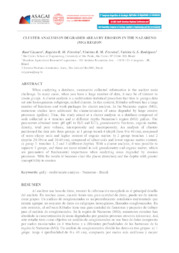Cluster analysis in degraded areas by erosion in the Nazareno (MG) region.
Cluster analysis in degraded areas by erosion in the Nazareno (MG) region.
Autoria: CASSARO, R.; FERREIRA, R. R. M.; FERREIRA, V. R. M.; RODRIGUES, V. G. S.
Resumo: Abstract: When analyzing a database, summarize collected information is the analyst main challenge. In many cases, when you have a large number of data, it may be of interest to create groups. A cluster analysis is a multivariate statistical procedure that tries to group a data set into homogeneous subgroups, called clusters. In this context, RStudio software has a large number of functions and work packages for cluster analysis. In the Nazareno region (MG), numerous studies have addressed the characterization of areas degraded by large erosive processes (gullies). Thus, this study aimed at a cluster analysis in a database composed of soils collected in 4 trenches and at different depths Nazareno?s region (MG) gullies. The parameters obtained were: pH (pH in H2O and KCl), granulometric fractions, organic matter, density, total pore volume, microporosity and macroporosity. An analysis of clusters partitioned the data into three groups: a) 1 group: trench 4 (depth from 0 to 40 cm), composed of more clayey soils and higher content of organic matter; b) 2 group: trenches 1 and 2 (depths 20-30 cm and 30-40 cm), composed of siltier soils and lower organic matter content; c) group 3: trenches 1, 2 and 3 (different depths). With a cluster analysis, it was possible to separate 3 groups, and these are more related to soil granulometry and organic matter, which are parameters of fundamental importance when analyzing areas degraded by erosion processes. With the results it becomes clear the places (trenches) and the depths with greater susceptibility to erosion.
Ano de publicação: 2021
Tipo de publicação: Artigo em anais e proceedings
Unidade: Embrapa Territorial
Palavras-chave: Gully, Multivariate analysis
Observações
1 - Por padrão são exibidas publicações dos últimos 20 anos. Para encontrar publicações mais antigas, configure o filtro ano de publicação, colocando o ano a partir do qual você deseja encontrar publicações. O filtro está na coluna da esquerda na busca acima.
2 - Para ler algumas publicações da Embrapa (apenas as que estão em formato ePub), é necessário ter, no celular ou computador, um desses softwares gratuitos. Sistemas Android: Google Play Livros; IOS: iBooks; Windows e Linux: software Calibre.
Acesse outras publicações
Acesse a Base de Dados da Pesquisa Agropecuária (BDPA) para consultar o acervo completo das bibliotecas da Embrapa.

